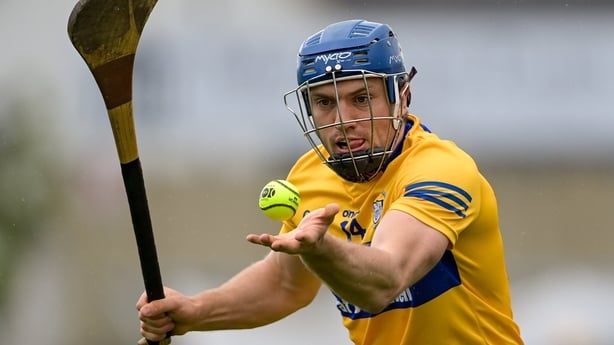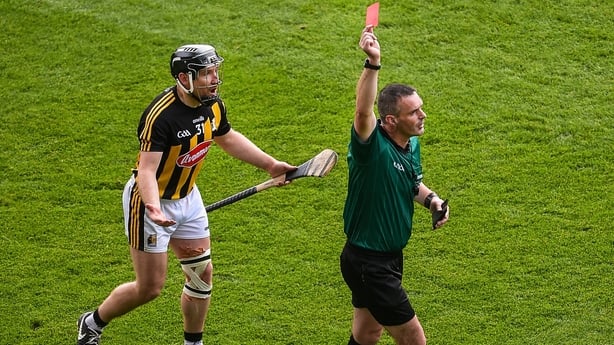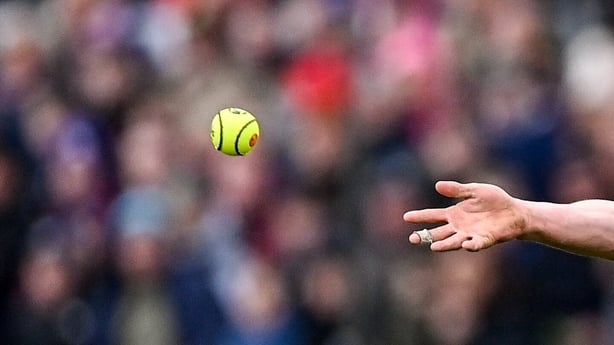Two weeks in and the hurling championship is heating up.
But is it threatening to boil over?
A notable feature of every round of games so far has been shoulders and hurls to the head.
Limerick and Waterford on the opening day in Munster saw several high hits, most of them involving the Déise's free-taker Stephen Bennett. In the 34th minute, Barry Nash slapped his hurl down onto the top of Bennett’s helmet. A minute later, Seamus Flanagan shouldered Bennett into the side of the jaw. In the 46th minute, Gearóid Hegarty received a second yellow card for a shoulder into the head of Conor Gleeson. In the 58th minute, Bennett caught Diarmaid Byrnes on the side of the head with what might charitably be called an attempted hook.
Last weekend, Galway’s Jack Grealish was fortunate to escape with a yellow for an arm/elbow to the head of Mikey Butler. Seven minutes earlier, Cian Kenny’s shoulder had caught the chin of Daithi Burke a glancing blow and he escaped a card completely, perhaps only because the Galway man stayed upright and you would fear as much for the Kilkenny sub’s scapula in that case.
Last night, there were two more shoulder-to-head blows. Dublin's Daire Grey caught Wexford Conor Devitt late on at Croke Park while Tipperary's Ronan Maher received a yellow card for doing the same to Cork's Darragh Fitzgibbon in the 15th minute at Páirc Ui Chaoimh.
Danny Sutcliffe and Cathal Barrett both received yellow cards for catching opponents around the neck with their arms.
"There have been several incidents now," says former Tipperary star Shane McGrath, who thinks players are unwisely banking on helmets to prevent serious injury.
"I’d say it’s going to take a red card in a big game for it to really sink in. And it’s probably going to have to happen soon.
"The hits that are going in, targeting lads head-high with your shoulder and your hurley… and thinking 'the helmet should save it somehow’. Maybe that’s a factor."
The common denominator in all of the above incidents was that none of the guilty parties received a straight red card. Devitt wasn't even awarded a free.
The consistently vague GAA rule book proscribes a sending off for a "strike or to attempt to strike an opponent" with the arm, elbow, hand, knee or hurley "with minimal force" (rules 5.16 and 5.17).
Distinguishing a deliberate strike with the hurl and a genuine attempt to hook or block is obviously difficult, apart from in the most blatant of cases, so a yellow card is generally given instead under rule 5.6 (To use the hurley in a careless manner).
The matter of a shoulder to the head is a more complicated one, not least because a shoulder-to-shoulder charge is perfectly legal.
It is not specifically mentioned under the rules and therefore it is left up to the referee to decide whether a yellow-card offence (To engage in any form of rough play 5.4; to charge an opponent in the back or front, or an opponent not in possession/playing the ball, rule 5.11) or red-card offence (to behave in any way which is dangerous to an opponent, 5.17) has occurred.
A shoulder to the head could also be considered worthy of no card if not considered ‘rough’.
Waterford still in it despite Limerick being on top and Seamus Flanagan lucky to still be on the pitch is the HT verdict of the RTÉ panel
— The Sunday Game (@TheSundayGame) April 23, 2023
📺 Live on @RTE2 and @RTEplayer https://t.co/ZfZ9mAavJw
📱 Live updates: https://t.co/Ku2ATEL3po
📻 Live on @RTERadio1#GAA #Hurling pic.twitter.com/MeRtIkqDNj
Speaking after the first round of games, four-time All-Ireland final referee Barry Kelly called the Flanagan incident "a miss" but said that "there are very close physical exchanges in a lot of areas and it’s really difficult to referee.
"Even going back to my time, ‘Around the head is red’ but you have to see these things," said the former inter-county whistler. "And sometimes you just don’t see them. It’s impossible to spot everything. If you get the majority of stuff right you’re doing well."
Kelly was satisfied that the Hegarty incident was a genuine attempt by the 6’5 Limerick forward to legally shoulder the 5’10 Conor Gleeson and therefore only worthy of yellow.
"A shoulder-to-shoulder tackle is a very exact thing. It’s only a couple of inches you’re gone from the top of the shoulder to the jaw-line and players are moving at such pace.
"He’s trying to hit a fella’s shoulder and either he moves and you move slightly and you get it wrong but just because a big lad hits a smaller lad, it doesn’t mean that it’s malicious. It’s mistimed in a lot of cases.
"Players are not going out to vindictively take lads out. The work they put in, no player wants to get sent off in a match and risk getting a suspension or losing his place. But if you go to shoulder someone and get that slightly wrong, you could easily face a red card."
Does it particularly matter if these incidents are missed? Well, apart from the advantage a team gains when their player is allowed to remain on the pitch after hurting an opponent, there is also the issue of concussion, which all sports are now slowly taking more seriously.
A study published earlier this year by academics from the Sport and Exercise Research Institute at Ulster University in Belfast identified an average of 2.23 incidents potentially concussive events (PCEs) per game over 82 inter-county hurling matches played between 2018 and 2019.
It also found that only 10 out of 43 players who showed one or more signs of concussion were removed from play, despite GAA guidelines being introduced in 2018 recommending they be removed from play and given a minimum 10-minute assessment. Congress voted to expand the 'blood sub' temporary substitution rule to cover checking suspected head injuries in 2021.

The study said that blows to the side of the head were 2.7 times more likely to result in visible signs of concussion than those to the front or back. A shoulder to the head was also 6.5 times more likely to result in a severe PCE than head contact from a hurley.
One of the study’s authors, Mario Rotundo, suggested that the GAA "might consider implementing more severe penalties, especially for 'blind-side' hits to the lateral aspect of the head, to encourage players to be more deliberate with their tackles."
He added that "Players should be taught from an early age that hits to the head, especially from the side on an unsuspecting opponent, can cause severe brain injury" and that "Referees might approach high-risk situations with a heightened awareness and have a lower threshold for issuing fouls and cards if necessary."
The GAA, LGFA, Camogie Association and Gaelic Players Association launched a concussion baseline testing programme last December with the admirable goal of "rapidly diagnosing and treating concussions in players".
But what can be done to prevent players from getting concussed in the first place?
Rugby, traditionally considered a far more physically aggressive sport than hurling, is in the process of trying to eliminate hits to the head from the game as the lawsuits from former players with brain injuries start to pile up - ominously for the GAA, legal cases have also been taken by amateurs.
Elite-level rugby has video reviews of potential dangerous play, Gaelic games, as yet, does not. But rugby also has the deterrent of its citing system, whereby offences deemed to have been incorrectly punished by officials are reviewed following the game.
The GAA rules, however, specify that the Central Competitions Control Committee can only issue suspensions for incidents a referee did not see. Liam Gordon reported that he saw the Flanagan incident at the time and deemed it a fair attempt at a shoulder, so no further action was possible, even if the ref felt he had made a mistake. Should there be a citing procedure more similar to rugby?
"[It would be] difficult to change it," suggests Kelly. "It’s there purely to allow retrospective action where the ref didn’t see it. If the rule changes then referees are constantly undermined, a bit like VAR [in soccer].
"Generally, referees are glad to correct obvious errors if they’re missed but the match being re-refereed is not desirable.
"I don’t see any major issue with discipline other than the fact that players are incredibly strong now and the game itself has changed tactically. Therefore, you’re going to have more close confrontation with a number of players involved and it’s difficult in a crowd to spot someone.
"By and large the games are a lot cleaner than they were years ago. The ‘hatchet man’ who would get away with something, there’s no way you would get with anything now off the ball. There are seven or eight pairs of eyes on you. It’s all on the ball."

Red cards in hurling often seem to dry up once championship comes but Kelly says that referees are aware that missing blatant offences will cost them high-profile appointments.
"The intensity level increases massively when it comes to championship," he says. "There is no comparison. It’s like different games.
"You referee accordingly, in a way. It’s not that you’re suddenly more lax but it’s a lot easier to referee a league game. Some league games, virtually nothing untoward happens, teams are not competing as ferociously.
"Any referee knows, if I miss a red card, or two red cards, my chances of being on duty in the key matches in July are about as good as a player who gets two or three red cards.
"Referees are very competitive as well and they want to be doing the big games. If you miss what’s perceived as red card, or give a yellow when it could have been a red, you’re not going to be getting the Munster and Leinster finals and All-Ireland semi-finals.
"Referees don’t want to give red cards but they’ll gladly give them if they see them."
More generally, Kelly feels that improved strength and conditioning and an emphasis on retaining possession through the hand-pass is leading to more congested play in hurling and increasing the likelihood of collisions
"It is only six years since I stopped refereeing at that level but it’s a much harder game to referee now," he said.
"The physical make-up of the players has gone to a new level. They are fitter and stronger. I think they relish the physical exchanges and want to show they have the power to cope.
"Teams are not contesting puckouts in a lot of cases and that means play is just condensed between the 45s, with a lot more bodies.
"Possession is so important now. Teams don’t give the 50-50 ball. The more hand-passing you have, the more physical contact."

Kelly is on a sub-group of the GAA’s Standing Committee on the Playing Rules examining the hurling hand-pass rule, which he says is "broken" due to the difficulty in distinguishing at high speed between a legitimate pass and a throw, up to 100 times per game.
"It is too simple to say ‘referees just be stricter’ because it’s unenforceable in terms of refereeing, there are so many of them now."
Clearer rules or citings on shoulders to the head, and hand-pass reform, could help to reduce the incidence of high-risk collisions. As could enforcing or reforming the widely ignored four-steps rule. There might have to be a longer-term conversation about video refereeing and limiting the force allowed in a shoulder-to-shoulder tackle. But those are all matters for GAA Congress.
In the meantime, a simple reminder to referees and players that hits to the head cannot be tolerated would make a difference.
The championship refereeing panel was due to meet earlier this week for a regular review and fitness session. It would be a surprise if high tackles were not part of that discussion and among the talking points on tonight's Sunday Game.
Watch highlights of the weekend's football and hurling championship action on The Sunday Game, 9.30pm on RTÉ2 and RTÉ Player


